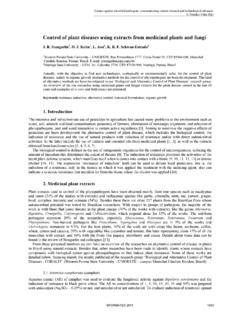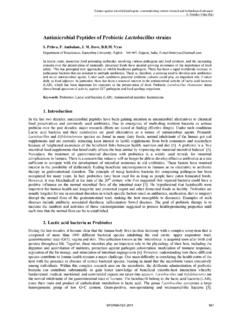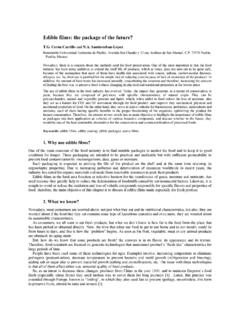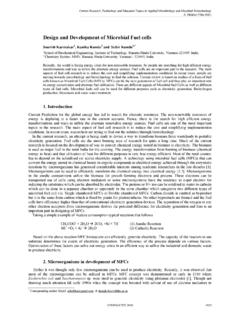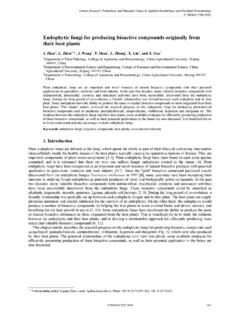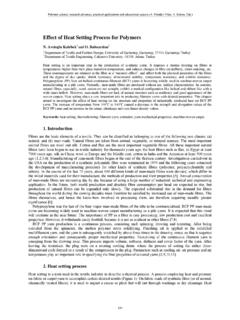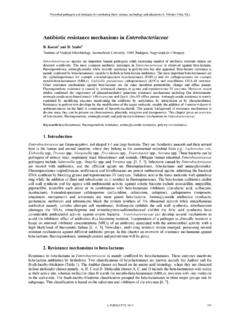Transcription of Cellulose-based hydrogels: Designing concepts, …
1 Cellulose-based hydrogels: Designing concepts, properties , and perspectives for biomedical and environmental applications Onofrei and A. Filimon* Physical Chemistry of Polymers Department, Petru Poni Institute of Macromolecular Chemistry, Iasi, 41A Grigore Ghica Voda Alley, 700487, Romania Development of new products and materials, especially those which are based on renewable organic resources using innovative sustainable processes, represents an increasing interest in both academic and industrial research. Cellulose and its derivatives have demonstrated to be versatile materials with unique chemical structure which provides a good platform for the construction of hydrogel networks with distinctive properties as respects of swelling ability and sensibility to external stimuli.
2 Indeed, the high density of free hydroxyl groups in the cellulose structure makes them become a solid substrate that can undergo functionalization, allowing the production of new materials for novel advanced applications. Moreover, the smart behaviour of these materials, in response to specific environmental stimuli, namely temperature, pH, ionic strength, determines the obtained hydrogels especially attractive for in vivo applications. Consequently, Cellulose-based hydrogels are promising materials, biodegradable, biocompatible, and the low cost, which exhibit properties that make them attractive in many applications, particularly in biomedical and environmental applications. Keywords: Cellulose-based hydrogels; biocompatibility; biomedical and environmental applications 1.
3 General remarks Hydrogels are material that exhibit three-dimensional network of hydrophilic polymers, capable to swell and retain a large amount of water within its structure [1]. The chemical crosslinking [2], physical entanglement [3], hydrogen bonds [4], and ionic bonds [5] are responsible to achieve the network of hydrogels. They can be obtained from the synthetic and natural polymers [6], and depend on various parameters, including the preparation method, charge, as well as mechanical and structural characteristics. Due to their excellent hydrophilicity, permeability, compatibility, and low friction coefficient, polymer- based hydrogels have been used extensively as drug delivery, food, cosmetics, high water-absorbing resin, contact lenses, corneal, implant, substitutes for skin, tendons, ligaments, cartilage, and bone [7,8].
4 Furthermore, an exclusive class of hydrogels - superporous hydrogels - can potentially be used for both short- and long term applications, as superdisintegrant, controlled release platform, and a gastroretentive drug delivery system. Also, superporous hydrogels have been successfully used as soil improvers [9], slow release fertilizers [10,11], pesticide release devices [12]. Recently, hydrogels have captured progressively the interest of researchers, due to the intrinsic properties corresponding of the medical applications. They can serve as scaffolds that provide structural integrity to tissue constructs, control drug, and protein delivery to tissues and cultures, and serve as adhesives or barriers between tissue and material surfaces.
5 The advantages provided by hydrogels for drug delivery applications include the possibility of sustained release, leading to the maintenance of a high local concentration of an active pharmaceutical ingredient over an extended period of time [13]. Their biocompatibility, ability to release water-soluble compounds from the polymeric matrix, and versatility in modeling the physico-chemical properties , permit the generation of new biomaterials with applications in controlled drug release. Among them, polymers of natural origin are one of the most attractive options, mainly due to their similarities with the extracellular matrix (ECM), chemical versatility, as well as typically good biological performance. It is worth noting that natural polymers have better biocompatibility and less latent toxic effect than most synthetic polymer hydrogels [14], so pure natural polymer hydrogels would be more suitable for biomaterials [15].
6 Indeed, polysaccharide- based hydrogels behave as smart materials and offer a variety of properties that can be exploited in several applications. Moreover, polysaccharides are gaining a particular attention as components of stimuli-responsive drug delivery systems, especially since they can be obtained in a well characterized and reproductible manner from natural sources [16]. In this context, they can be promising for application in the biomaterial domain, due to their unique benefits, like non-toxicity, abundance, biodegradability, biocompatibility, and biological functions [17]. The most important properties of polysaccharides are derived from natural sources, and their difficulty imposed new synthetic chemical modification methods, the aim being to promote new biological activities and to modify their final properties for specific goals.
7 Furthermore, polysaccharide- based materials have opened new roads in the biomedical domain, namely in the tissue engineering of controlled drug delivery systems and cell immobilization. According those above-mentioned, cellulose represents the most abundant renewable and biodegradable polymeric material, being considered as the main constituent of plants and natural fibers. Also, cellulose is an environmentally friendly alternative to conventional materials and exhibit properties that make them very attractive in many applications [18]. Nowadays, cellulose derivatives- based hydrogel have gained a great popularity in agriculture and pharmaceutical industry, and Polymer science: research advances, practical applications and educational aspects (A.)
8 M ndez-Vilas; A. Solano, Eds.) _____108 become more and more important in these fields, owing to production of the new derivatives with extended applications. Considering the extensive possibilities to use the new materials, this work introduces the information on the intelligent cellulose hydrogels, which are able to respond to environmental changes by modification their characteristics and finally, presents their possible applications in different fields. From this reason, the present chapter covers the applications of cellulose based hydrogels in the pharmaceutical and biomedical area. Furthermore, the Cellulose-based hydrogels can become green via replacing the synthetics with the bio- based materials, and implicitly are suitable in the environmental protection, being developed for the optimization of water resources in agriculture.
9 2. Cellulose-based hydrogel applications Excellent biocompatibility of the cellulose and cellulose derivatives determine their wide use in different applications, such as in pharmaceutical compounded and industrialized products. Cellulose esters and cellulose ethers are two main groups of cellulose derivatives with different physicochemical and mechanical properties . Thus, cellulose esters compounds are water insoluble polymers with good film-forming characteristics which find a variety of applications, as classical material-coatings and controlled-release systems, hydrophobic matrices, and semipermeable membranes for applications in pharmacy, agriculture, and cosmetics. Additionally, cellulose esters ( , cellulose acetate (CA), cellulose acetate phthalate (CAP), cellulose acetate butyrate (CAB), cellulose acetate trimelitate (CAT), hydroxypropylmethyl cellulose phthalate (HPMCP)) are used extensively as binders, fillers, and laminate layers in composites and laminates, as excellent material for photographic films, and as membrane-forming materials applicable for gas separation, water purification, food and beverage processing, medicinal and bioscientific fields [19-21].
10 On the other hand, cellulose ethers which present a good solubility, high chemical resistance, and non-toxic nature are utilized in drilling technology and building materials, as additives for drilling fluids and processing of plaster systems, as well as stabilizers in food, pharmaceutical, and cosmetics formulations as the main component. Moreover, cellulose ethers are widely used as important excipients for Designing matrix tablets [22,23]. The most commonly used cellulose ethers are: methyl cellulose (MC), ethyl cellulose (EC), hydroxyethyl cellulose (HEC), carboxymethyl cellulose (CMC), sodium carboxymethyl cellulose (NaCMC), hydroxypropyl cellulose (HPC) and hydroxypropylmethyl cellulose (HPMC) [24,25]. Cellulose ethers are generally hydrophilic and convert to hydrogel after exposing to water.
